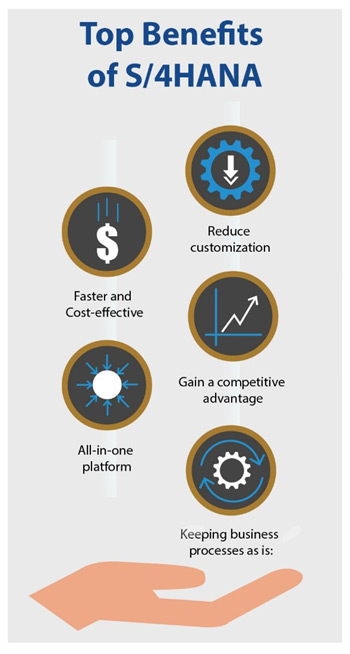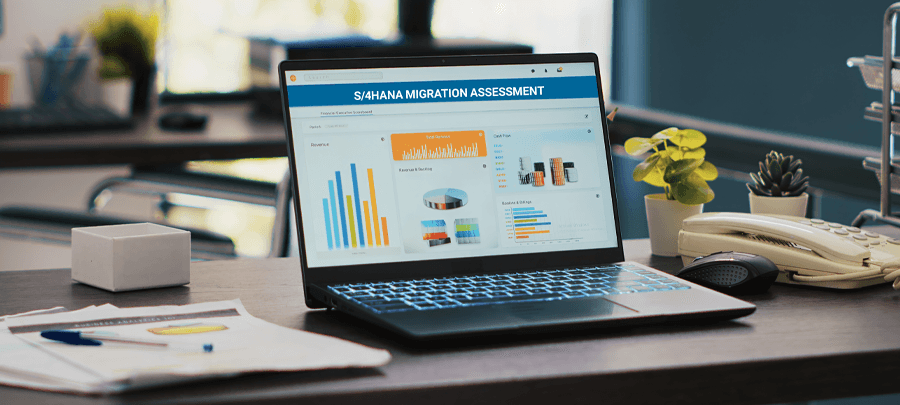6 key reasons why you should move to S/4HANA now
05 October 2022


Richard Pascoe
Vice President - Consulting ServicesRichard Pascoe is the VP- Consulting Services, Applexus Technologies, UK. An experienced leader and business development manager, Richard has been accountable for the success of the...
Businesses on the legacy SAP ERP Central Component (ECC) may be planning to stick around, despite the success of S/4HANA. A host of reasons such as fewer internal resources, lack of organizational focus, change management concerns, huge financial investment, return on that investment, lack of understanding of the benefits of upgrading, and a sense of comfort in ECC led them to dismiss or at the very least delay the move to S/4HANA.
Even the greater agility, scalability, performance, enhanced business processes, and analytical capabilities in the superior S/4HANA haven’t been enough to convince many business stakeholders and decision-makers to make the switch. The familiarity with ECC and all the business functions working well, the migration never made sense for some organizations. ECC gives them all they need. But, with the end of support impending for ECC, this will either increase the cost of ownership or force a time to move which may not be optimal.
SAP intends to pull the plug on ECC, they will cut off standard support for the current SAP ERP systems by 2027. SAP has already extended the end date from 2025 to 2027, so they are unlikely to move it further. The end of mainstream support effectively leaves businesses vulnerable or forces them to jump to S/4HANA or any other alternative solution rather than risk jeopardizing their business or facing expensive extended support.
As of the second quarter of 2022, SAP reported a total of 20,000 subscribers for its S/4HANA ERP package - Statista1
What does it mean for such businesses?
If your business was to retain the earlier version of SAP post-2027, expect to run into various bottlenecks, that may make it harder for you to focus on running your processes more seamlessly. The out-of-date system will have you occupied with maintaining and managing an ecosystem with dated capabilities and less functionality to respond to business challenges and customer behavior. Your business will receive diminishing service from the SAP partners and community as skilled resources move towards future-proofing their own business and will also cease to receive routine enhancements and security patches.
This will make it harder on you to run the ERP system efficiently or respond to changes in your business. It will add to your variable expenses, as system incompatibilities and hardware costs will rise, besides of course the additional labor charges to support and sustain the potentially fragile system. Extended support from SAP will also prove costlier, meaning your business will incur a higher fee, above and beyond what you are paying now. Also, there is no guarantee in place at the moment, if such a service will be made available.
Migrate to S/4HANA now – Top 6 reasons
1) All businesses may wait: Currently, there are a vast number of businesses on ECC. Most of them may wait till 2027 and choose to migrate simultaneously, which will reduce the availability of qualified SAP resources, increasing the value of such resources at the very least, making them more expensive, even if there is any availability. At the same time, those choosing to seek alternative software will face the same issues from other ERP software vendors who will also be resource constrained, given the number of SAP customers today.
The move to SAP S/4HANA is no easy decision. Procrastinating the shift to the same may put you on a collision path with other organisations. SAP Resources that are already engaged on their migration project may not free up time for yours, or worse, abandon your project in favour of a more lucrative one, leaving your business in danger. Considering the complexity of the system conversion it would be best to switch sooner than get caught up in the transition wave around 2027.
2) Avoid a Disruptive Move: A last-minute, abrupt migration to S/4HANA can result in quality issues, oversights, business disruption, and change management issues. Businesses may find it hard to cope with the overwhelming number of enhancements and internal conflicts. A large-scale migration requires detailed planning and data-driven analysis, alongside time and resource allocation.
Today, you have the flexibility to plan the process out in length, manage the current systems, arrange backup, handle any pitfalls, and complete the entire overhaul more meticulously. A less time-intensive and deadline-driven migration to S/4HANA is more likely to succeed and not throw up any quality issues.
3) Not enough SAP or alternative ERP resources: Barely enough qualified and experienced resources to cope with such a massive shift are available today. At the last moment, when the deadline is looming closer, you and SAP Partners are unlikely to find enough knowledgeable consultants who can guide you to a successful SAP S/4HANA migration. Applexus is developing a team of future consultants already to address our own forecasts, but a bottleneck of SAP experts may make it hard to complete or even initiate a successful transition to SAP S/4HANA or any other alternative software given SAP’s current dominance.
4) Spike in consultant charges:Last-minute hurried migration will result in a shortage of skilled consultants. Knowledgeable consultants and experts will not be readily available to facilitate the SAP S/4HANA transition. The unavailability of quality resources will increase demand versus supply, thereby resulting in some serious increase in rates for those who carry the requisite skills to take on such a project. Fully aware of what your business is going through, these consultants will naturally increase their rates in line with demand, proving more financially destructive to your business and preparing themselves for the potential decline in project availability once the majority of organizations have transitioned.
5) Future-proof your IT investment: The sooner you embrace SAP S/4HANA, the sooner you can modernize your business ecosystem. Investing in your legacy ERP and carrying out more customization, development, and integration will only take you backward. SAP is actively investing in S/4HANA while no longer investing in SAP ECC, as you would expect. Developing software solutions is an expensive and high-risk business and keeping the two solutions aligned is not possible in the long term. You want to keep up and future-proof your systems and processes. With SAP ’s future outlook and move towards an evolving and innovative solution delivering more value, staying with a regressive system that promises more risks and fewer rewards down the line may not give the best returns.
6) Avoid a double investment: If your business is considering renewing the hardware or hosting solutions for the current SAP system, rethink your decision. It may not be wise to spend significant dollars on a dated system, that will eventually run its course and not give your significant value (Returns) in the long run. Consider upgrading to S/4HANA Cloud (public/private). This way you won’t have to spend on maintaining the current setup and spend extra when it’s time to upgrade to S/4HANA in 2027.
Top benefits of S/4HANA
Reduce customization: Staying on ECC may mean more code customizations in your business environment. This increases development hours, risks, and effort, consumes more time and leads to more expenses. The out-of-date ECC system won’t adapt as well past 2027, needing coding, and we are not just talking about slight tweaks but complex coding to keep it current with the needs of your business. Plus, changes to one part can severely affect other interconnected areas, requiring code changes over there as well. It’s better to move to S/4HANA, considering SAP has already switched to investing 20% of its turnover in R&D for S/4HANA rather than ECC resulting in newer functionality aligned to the ever-changing business market.

Faster and Cost-effective: S/4HANA’s flagship in-memory database provides improved performance for complex business processes. S/4HANA offers increased scalability, and the in-memory design of SAP’s HANA database increases processing speeds. S/4HANA delivers planning, execution, analytics, and reporting at exponential speeds. Also, companies on SAP S/4HANA process larger volumes of data with fewer resources. This lets you do more with less to reduce the time-to-value and in some cases reduce time-to-market. Deployment options in cloud or hybrid lower infrastructure investment and optimize the total cost of ownership.
Gain a competitive advantage: Get a head start in your industry against your competitors by making the move to SAP S/4HANA, incorporating a wealth of new features and applications such as embedded machine learning, advanced analytics, better user interfaces through SAP Fiori, intelligent processes, and much more to make your business more robust and prepared for any disruption, besides being able to capture your objectives better with the modern, intelligent ERP ecosystem of S/4HANA.
All-in-one platform: The S/4HANA suite has many features to support your business processes across all touchpoints at unprecedented speed for fast decision-making and near real-time insights. The modern features and user-friendly Fiori interface let you manage your business across all channels and that too from any device. The groundbreaking S/4HANA solution will streamline and transform Small, Medium, and Large Enterprise businesses to deliver tangible value for every business function.
Keeping business processes as is: S/4HANA allows you to not just work with the current processes but accelerate the same to realize quality output in far less time. You don't need to go through a full-blown system conversion. Instead, SAP S/4HANA, with the power of SAP HANA Database applies speed to a simpler data model and eliminates redundancies, batch processing, and other bottlenecks to result in improved productivity, which goes on to give incremental savings down the line.
Newer Functionalities of S/4HANA

In addition to the business drivers to move now, there are also the additional functionalities available as a resu q qq qlt of that 20% R&D investment that SAP makes into the product itself, below is just a taster of some of the functionalities recently added to the latest version of S/4HANA:
Supply Protection: The Supply Protection feature can help businesses avoid shortages, avoid leftovers, and sell with a high margin whilst protecting your most valuable customers or channels to market. Supply protection is important when there is a disruption in the supply chain forcing difficult decisions to service preferred customers or those with higher strategic importance. With Supply protection, you can define a minimum quantity for a certain company or channel leaving you with enough stock for other clients’ ring-fencing stock without physical separation.
Using SAP S/4HANA, HMD Global realized a 50% reduction in order management costs and 90% lower IT costs than other similarly-sized companies - SAP 2
Embedded Analytics: Embedded Analytics serves as a collection of predefined analytical apps with Core Data Services (CDS) views, smart business cockpits for KPI, and intuitive dashboards that use SAP Fiori as the front-end user interface to enable real-time analytics and real-time operational reporting on live transactional data. Compared to traditional ERP and data warehouse systems, embedded analytics doesn’t have ETL (Data Extraction, Transformation, and Loading) and batch processing. Embedded analytics empowers businesses to gather and view data at the origin to drive insights, and complete business processes in a single interface, relying on a single source of facts without switching between multiple applications.
Business users can leverage standard content as an accelerator for their implementation, which can also be personalized and extended based on business requirements. These analytics features can be integrated into core business processes such as customer segmentation, planning & forecasting, cross-sell & up-sell to make informed decisions. Finally, embedded analytics can take advantage of the underlying advanced analytics capabilities in the SAP HANA platform to look beyond historic data when it comes to forecasting for your business.
Flexible Purchasing: The Flexible Purchase capability in SAP S/4HANA allows businesses to develop purchase contracts with a generic article, with or without variants as subitems. This ability enables businesses to create purchase contracts with only a generic article if the variant is optional. In essence, companies can develop purchase contracts, only specifying the generic article with the ability to add variant specifications later. Destination Postponement, where ship-to destinations get decided last moment, and Finished Goods Commitment, concerning finished goods production commitments across a global supply chain, are the two challenges that SAP helps address with Flexible Purchase Commitment (FPC). FPC helps businesses adopt procurement processes, stay agile, and add variants later.
Pack Separately, Ship Together (PSST): Pack Separately – Ship Together (PSST) helps you identify the order items that need to be shipped together. The Pack Separately – Ship Together capability offers a real market advantage by allowing businesses to create and use grouping r qules to group articles that would need to ship together. PSST makes it possible to have individual order items strategically consolidated into a single shipping order - making it more logistically convenient and economical for the business. Businesses won’t need to deliver items separately, one after the other, and incur higher logistics costs on multiple shipments or risk delaying the order for an integral component, resulting in customer dissatisfaction. Once goods have been delivered, the ability to cross dock initial items for stores or wholesale customers is enabled, allowing the other items’ packets to be put in bulk for later use in replenishment operations.
Business Technology Platform (BTP): Business Technology Platform serves as a powerful digital foundation to accelerate digital innovation, create powerful solutions, and achieve continual value across several functions of your business. BTP helps your business stay agile and ready for any disruption with Application Development and Automation, integration, and enterprise planning, besides helping to maximize the value of SAP data, realizing reliable insights, and infusing Artificial intelligence (AI) in your apps.
Wrapping Up
The biggest dilemma that companies are facing now is whether to continue with ECC or make the switch to the more adaptive, real-time, and modern system that is S/4HANA. And if they choose to migrate, when is the right time? After all, before pushing for S/4HANA they may need to do extensive analysis, develop a roadmap, align resources, free up capital, and make other assessments.
However, on the whole, a move to the functionally rich S/4HANA from the out-of-date ECC makes more sense now. Migrating before 2027 ensures you avoid the risks of getting caught up in a phase where all businesses are competing for the same resources. Undertaking a rushed migration with fewer and underqualified resources may even undercut the value you stand to receive.
1 Vailshery LS, Aug 9, 2022, Quarterly number of SAP S/4HANA subscribers worldwide, from 2015 to 2022, by quarter, Statista, https://www.statista.com/statistics/590976/sap-hana-s4hana-customer-numbers
2 SAP, May 22, 2022, HMD Global: A Unicorn Leverages Integrated ERP Technology in the Cloud to Revitalize a Fabled Brand, SAP SE, https://www.sap.com/products/erp/s4hana.html?pdf-asset=ea29b53d-2a7e-0010-bca6-c68f7e60039b&page=1











